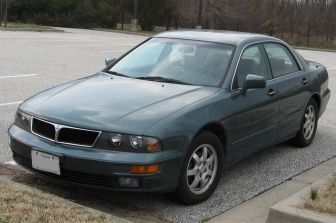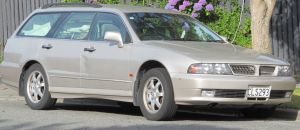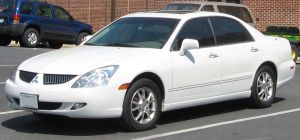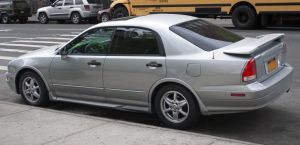Second-gen Diamante
The second generation of the Diamante was introduced to the Japanese market in January 1995. The Sigma variant was eliminated and not renewed for a second generation, due to poor sales in Japan; most Sigmas sold had become taxis and patrol cars.
The Diamante was marginally larger with improved headroom. It was powered by several engines: the base engine was a 2.5-liter MVV (lean burn) V6, followed by a number of 2.5 and 3.5-liter variants, the 2.5-liter engine sported 175hp and the 3.5-liter engine boasted 210hp. The new Diamante range in Japan topped off with a 3.0-liter MIVEC V6. In its latter years, the Diamante range was reduced to a single engine offering in Japan, first a 3.0-liter GDI V6 with 240hp (the first of its kind), and then a conventional 2.5-liter V6.
The Australian produced Verada came off the production line on 1 July 1996, and now formed the basis of all Diamantes sold outside Japan. Both the Verada (designated the KE series in Australia) and the Magna (TE series) on which it was based, won the 1996 Wheels magazine's Car of the Year award.
Sales on the US market commenced with the 1997 model year in late October 1996, where it occupied "near luxury" segment and competed on price with vehicles like the Lexus ES 300. The Diamante featuring export-only extra equipment such as keyless entry, but never featuring the eventual all wheel drive (AWD) drivetrain that became available for the Australian and New Zealand range (respectively badged Verada and Diamante). The North American Diamante also didn't receive an automatic with a manual-shift mode until 2004, and even then it was available only in LS and VR-X models and had only four speeds.
These Australian export models were mechanically different from the Japanese Diamante since the latter:
- had multi-link front and rear suspension (whereas the Australian version had more basic MacPherson front struts);
- only featured leather trim (Verada Ei featured cloth trim);
- had a foot-operated parking brake (whereas the Australian production featured a conventional lever design)
- had a pressed steel front cross-member.
In addition, with the Japanese Diamante, Mitsubishi introduced more technological innovations including:
- a more advanced Traction control system (which was later introduced in Australia and therefore all export models);
- satellite navigation system with a display featuring prominently on the center console;
- Heads-Up Display;
- a distance/lane-keeping system that tracked lanes and cars ahead using a set of laser and camera (being technology first adopted by the 1992 Debonair);
- the world's first five-speed automatic transmission in a transverse-engined drivetrain, complete with INVECS-II software logic and Tiptronic-functionality (the latter also subsequently introduced on Australian models from the KJ-series).
Australia was also the source of all Diamante wagons, for its domestic market and export markets including Japan, where their sales commenced in October 1997.
The exterior was refreshed for 2002 at which time, the Diamante won New Zealand's Car of the Year award. A radical restyle followed with the presentation at the 2003 New York International Auto Show of a new Diamante adopting the then new corporate look. Mitsubishi ceased to export the Diamante to North America after 2004 due to a decline in sales and unfavourable exchange rates. The U.S. market Galant grew in size, and the Diamante was replaced by the upper-end GTS trim of the Galant.
In Japan, the Diamante did not receive the extensive 2002 and 2004 restylings of the US and Australian/New Zealand models. It continued in its original narrow-body 1995 form until 2005.
On 15 June 2005, Mitsubishi announced it would halt production on larger sedans within Japan by December of that year, affecting both Diamante and Galant models. The production of the Magna/Verada combo by Mitsubishi Motors Australia continued unaffected.
VR-X
Introduced in 2002, the VR-X was a sporty variant of the Australian-made Diamante exported to North America. It was continued with the 2004 restyling.
The 2002 model's exterior was based on the top-of-the-range Australian KJ-series Verada sedan, whereas its mechanicals and fittings were derived from a combination of other Australian-made models:
- Stiffer sports suspension from the limited edition Verada GTV (which, in turn, inherited it from the Magna Sports/VR-X sedans);
- 16-inch sports alloy wheels from the Magna Sports;
- Leather trim and electric seats from the Verada Xi;
- White "VR-X"-marked instrument fascia from the Magna VR-X (as opposed to the standard Diamante and Verada electro instruments);
- Silver centre console trim and 2-tone leather steering wheel from the Magna VR-X Limited Edition (losing the other Diamante's radio remote control);
- Bodykit featuring front wheel arch extensions and wheelbase skirts from the Magna VR-X, plus unique rear wheel arch extensions and bootlid spoiler.
Unique to the American VR-X was a 270-watt, eight-speaker sound system and its engine was a 3.5-liter V6 engine that developed 210hp compared to the standard Diamante's 3.5-liter V6 engine's 205hp. This VR-X did not, therefore, feature the Australian "high output" version fitted to the Magna Sports/VR-X based Verada GTV, whose engines were mated to an advanced five-speed tiptronic automatic transmission (or also a five-speed manual in the case of the said Magna models).
The 2004 model continued the above mix of features but this time became more directly based on the TL-series Magna. Specifically, unlike the standard Diamante models that were Verada on the outside, the 2004 model was based on the Magna VR-X (for example, the rear light cluster were identical between these two). This Diamante VR-X inherited the 16-inch alloy wheels from the Australian Magna VR-X AWD (notably, the front-wheel drive Magna instead had 17-inch alloy wheels and the Magna Sports was no longer the wheel donor car because it was discontinued by this time). Electric seats and leather trim remained Verada-derived fittings. The steering wheel remained the 2-tone leather unit of the 2001 TJ series Magna VR-X Limited Edition (that became an optional accessory available across the Australian range).
This article uses material from the “Mitsubishi Diamante” article on Wikipedia and is licensed under the Creative Commons Attribution-Share Alike License.



